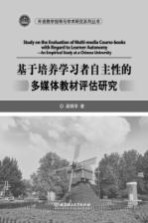

基于培养学习者自主性的多媒体教材评估研究 英文PDF电子书下载
- 电子书积分:7 积分如何计算积分?
- 作 者:梁铜华著
- 出 版 社:北京:北京理工大学出版社
- 出版年份:2015
- ISBN:9787568207034
- 页数:94 页
Chapter 1 Introduction 1
1.1 Background information 1
1.2 Objectives of the research 3
1.3 Rationale for the research 4
Chapter 2 Literature Review 6
2.1 Definition of learner autonomy 7
2.2 Rationale for promoting learner autonomy 8
2.3 Major components of learner autonomy 9
2.3.1 Learning management 10
2.3.2 Cognitive processes 10
2.3.3 Learner control over learning contents 11
2.4 Approaches to the development of learner autonomy 11
2.4.1 Analyzing learners'needs 11
2.4.2 Multiplying teacher's roles 12
2.4.3 Enhancing the use of technology 13
2.4.4 Ensuring the quality of course-books 14
2.5 Research on course-book evaluation 15
2.5.1 Definitions of course-book and related terms 15
2.5.2 Roles of course-books 16
2.5.3 Types of course-book evaluation 17
2.5.4 Processes and means of the course-book evaluation 18
2.5.5 Rationale for evaluating course-books with regard to learner autonomy 19
2.5.6 Guidelines for course-book evaluation 20
Chapter 3 Methodology 22
3.1 Rationale for using different research tools 23
3.2 Unstructured interviews 24
3.2.1 Subjects 24
3.2.2 Procedures 25
3.2.3 Findings 26
3.3 Questionnaire with open questions 27
3.3.1 Subjects 27
3.3.2 Design of the questionnaire 27
3.3.3 Data-analysis 28
3.3.3.1 Students'responses to the questionnaire 28
3.3.3.2 Teachers'responses to the questionnaire 31
3.4 Questionnaire with closed questions 33
3.4.1 Design 33
3.4.2 Subjects 34
3.4.3 Data-analysis 34
Chapter 4 Results and Discussion 37
4.1 Factor analysis 37
4.1.1 Exploring the data's appropriateness for factor analysis 37
4.1.2 Identifying the factors 39
4.1.3 Naming the factors and reporting the results 39
4.2 Discussions about the major factors 44
4.2.1 Subjects'learner autonomy 44
4.2.2 Evaluation of course-books with regard to learner autonomy 47
4.2.2.1 External evaluation of the course-books 47
4.2.2.2 Internal evaluation of the course-books 50
4.2.2.3 Overall evaluation of the course-books 52
4.2.3 Additional effects of the course-books 54
4.2.4 Subjects'needs for English 55
4.2.5 Subjects'needs for English listening and speaking 57
4.3 Correlations between the five major factors 61
Chapter 5 Conclusions 67
5.1 Findings 67
5.2 Limitations of the research 68
5.3 Suggestions for further research 69
Bibliography 71
Appendices 80
Appendix One Checklist of the unstructured interview 80
Appendix Two 教师调查问卷 81
Appendix Three 学生调查问卷 82
Appendix Four Questionnaire 83
Appendix Five Factual details of materials to be evaluated 93
- 《党员干部理论学习培训教材 理论热点问题党员干部学习辅导》(中国)胡磊 2018
- 《深度学习与飞桨PaddlePaddle Fluid实战》于祥 2019
- 《长三角雾霾突发事件风险评估、应急决策及联动防治机制研究》叶春明著 2019
- 《全国普通高等中医药院校药学类专业“十三五”规划教材 第二轮规划教材 有机化学学习指导 第2版》赵骏 2018
- 《有机磷酸酯的暴露、毒性机制及环境风险评估》许宜平,王子健等著 2019
- 《基于核心素养的有效学习与学业评价策略 初中政治》李亚莉主编 2018
- 《人体寄生虫学学习指导与习题集 供基础 临床 预防 口腔医学类专业用 第2版》诸欣平,苏川 2018
- 《大学信息技术基础学习与实验指导教程》安世虎主编 2019
- 《农田温室气体排放评估与减排技术》江丽华编著 2019
- 《牛津中国心理学手册 上 认知与学习》(美)迈克尔·哈里斯·邦德主编;赵俊华,张春妹译 2019
- 《刘泽华全集 先秦政治思想史 下》刘泽华著;南开大学历史学院编 2019
- 《口译理论研究》王斌华著 2019
- 《陶瓷工业节能减排技术丛书 陶瓷工业节能减排与污染综合治理》罗民华著 2017
- 《郎才女貌》李之华著 1942
- 《最美的时光》桐华著 2020
- 《禅宗精神与后现代精神的“家族相似”》邱紫华著 2019
- 《钢琴演奏与钢琴教学研究》张鲜华著 2018
- 《澳门人家》梁振华著 2019
- 《春日之书》陆烨华著 2019
- 《刘泽华全集 先秦政治思想史 上》刘泽华著;南开大学历史学院编 2019
- 《大学计算机实验指导及习题解答》曹成志,宋长龙 2019
- 《指向核心素养 北京十一学校名师教学设计 英语 七年级 上 配人教版》周志英总主编 2019
- 《大学生心理健康与人生发展》王琳责任编辑;(中国)肖宇 2019
- 《大学英语四级考试全真试题 标准模拟 四级》汪开虎主编 2012
- 《大学英语教学的跨文化交际视角研究与创新发展》许丽云,刘枫,尚利明著 2020
- 《北京生态环境保护》《北京环境保护丛书》编委会编著 2018
- 《复旦大学新闻学院教授学术丛书 新闻实务随想录》刘海贵 2019
- 《大学英语综合教程 1》王佃春,骆敏主编 2015
- 《大学物理简明教程 下 第2版》施卫主编 2020
- 《指向核心素养 北京十一学校名师教学设计 英语 九年级 上 配人教版》周志英总主编 2019
